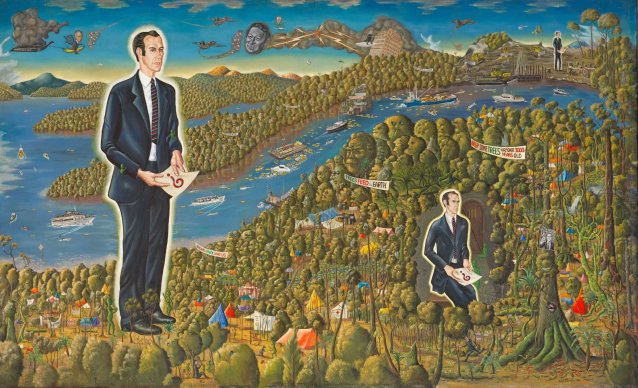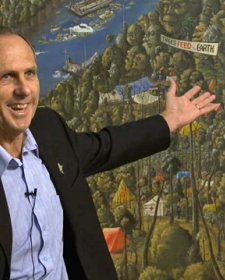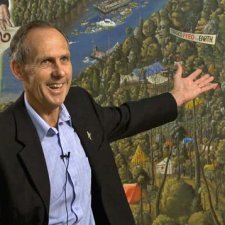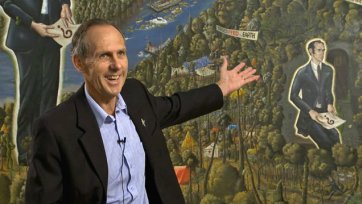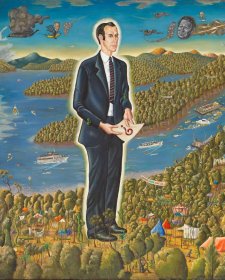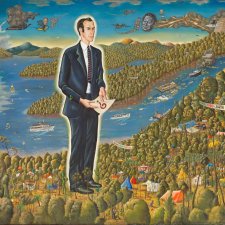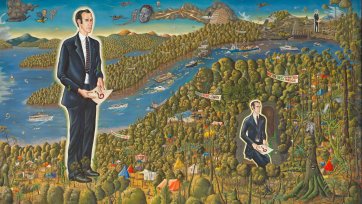, 1983 Harold Thornton. © Estate of Harold Thornton
Bob Brown (b. 1944) is an environmental campaigner, former senator and the first Parliamentary Leader of the Australian Greens. Born in Oberon, New South Wales, he studied medicine at the University of Sydney and worked in hospitals in Canberra, Darwin, Alice Springs and London. After moving to Tasmania, he worked as a general practitioner in Launceston while becoming one of the activists engaged in the critical fight against the Hydro Electric Commission's plan to dam the Huon and Serpentine rivers in the island's south-west. That fight was lost, resulting in the inundation of Lake Pedder and over 240 square kilometres of unparalleled wilderness in 1972. The same year, Brown joined the United Tasmania Group – considered the world's first green political party. He was a founding member of the Wilderness Society in 1976, the year in which he also undertook a rafting trip down the Franklin River. The journey crystallised Brown's commitment to the protection of Tasmania's wilderness, in much the same way as the loss of the fight to save Lake Pedder galvanised the campaign to save the Franklin when a newly elected state government resurrected HEC plans to dam it in 1982. Brown led the campaign for the Franklin's preservation – arguably the most significant environmental action in Australia to date. In mid-December 1982, non-violent protesters commenced their occupation of the dam site on the same day that UNESCO met in Paris to confer World Heritage status on Tasmania's wild rivers. Over the next few months, hundreds of protestors were arrested and jailed, including Brown, who also received death threats. The new Federal government under Bob Hawke, elected in March 1983, promptly legislated to prevent the dam's construction. When the Tasmanian government ignored the new laws, the Commonwealth took it to the High Court, which ruled in the Commonwealth's favour in July 1983. Brown began a decade in the Tasmanian parliament that year. He was elected to the Federal Senate as a member of the Tasmanian Greens in 1996 and then co-founded the Australian Greens with Western Australian Greens senator Dee Margetts. He oversaw the emergence of the Greens from a fringe to a mainstream political force, and he remains known for his outspokenness on the environment as well as human rights and social justice issues. After retiring from politics in 2012, he established the Bob Brown Foundation, and is currently an integral member of the committee campaigning to reverse the damage to Lake Pedder.
Artist Harold 'The Kangaroo' Thornton was one of ultimately 6000 protestors who formed the Franklin River blockade. He worked on this picture – part portrait, part quixotic history painting – while he was in the campsite and in his Hobart and Sydney studios. Despite its fanciful elements, the painting provides a remarkably faithful record of events, its details including images of the British botanist David Bellamy, who joined the protest; of the aircraft that obtained photographic evidence that the dam was being constructed in defiance of the law; and of police officers who surreptitiously expressed their support for the greenies by wearing No Dam stickers on the inside of their hats. Pro-dam Tasmanian premier Robin Gray is depicted as a disembodied grey head, with the Hydro Electric Commissioner pulling his strings. Thornton also included himself in the composition as the tiny, bespectacled face beside the blue tent in the bottom left-hand corner. The almost four-metre wide canvas was a finalist for the 1983 Archibald Prize.
